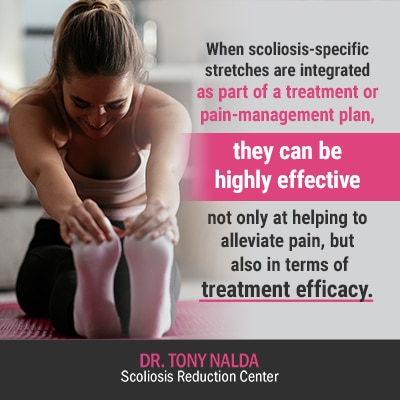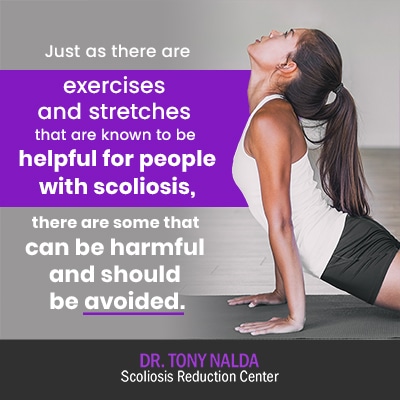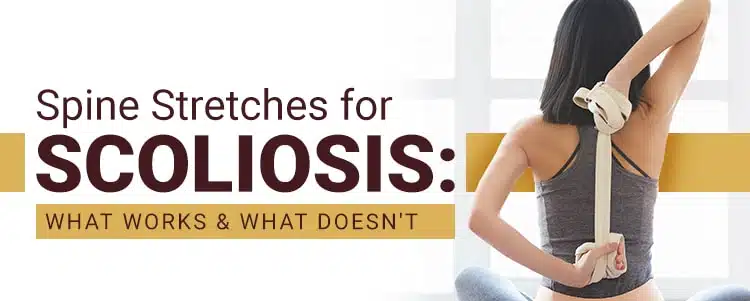At one time, the role of exercise in scoliosis treatment was questioned, but we have since learned that staying active, working to maintain flexibility, and keeping the spine and surrounding muscles as loose as possible is highly beneficial. However, knowing which exercises and stretches are the most scoliosis-friendly is equally as important as knowing the stretches that don’t work and can actually exacerbate symptoms.
While no spine stretch has the potential to induce a structural change on its own, when used in conjunction with other treatment disciplines, spine stretches can help augment scoliosis treatment results and manage pain. The best spine stretches for scoliosis are those that help strengthen and relax uneven muscles; the worst are those that work the spine asymmetrically.
While stretching is highly beneficial for people with scoliosis, those stretches need to be scoliosis-specific. In addition, any effective treatment approach should involve a customized treatment plan, designed by a scoliosis specialist, and part of that plan should be an exercise regime that addresses the patient and the unique characteristics of their condition. Before we move on to specific spine stretches for scoliosis, let’s explore what’s happening in the body of someone living with scoliosis.
Living with Scoliosis
With close to seven million people currently living with scoliosis in the United States alone, scoliosis is a highly prevalent spinal condition.
While there are different forms of the condition, its most common form is adolescent idiopathic scoliosis (AIS), which is diagnosed between the ages of 10 and 18.
The two main forms of scoliosis in adults are idiopathic and degenerative. In idiopathic scoliosis in adults, these are cases of AIS that remained undiagnosed until reaching adulthood, when it’s likely the condition started to produce noticeable symptoms such as back pain.
Degenerative scoliosis affects people as they age and the spine becomes vulnerable to the effects of years of wear and tear and the cumulation of lifestyle choices.
When scoliosis is present, this means there is an abnormal sideways bend to the spine, measuring at 10+ degrees, that includes rotation. This is a structural issue and needs to be addressed as such during treatment to achieve a curvature reduction.
As a progressive and incurable condition, this means that even with successful treatment and a curvature reduction, the condition will still be present. Even after the completion of the most intense portion of treatment, work will have to be done to sustain those results; part of that work is living as scoliosis-friendly a lifestyle as possible.
This means knowing which types of activities and exercises are safe, and which to avoid. Of course, no one should ever attempt a change in exercise regime without first consulting with whomever is administering their treatment; this is also important in terms of getting guidance on which exercises actually have the potential to complement treatment.
While scoliosis isn’t known to cause a lot of functional deficits in its earlier stages, especially in AIS, as it moves into the severe stage of progression, its symptoms tend to get more extreme, and postural changes become more and more pronounced.
The body is remarkably good at adjusting to structural changes. As a person’s scoliosis progresses, the body tries to compensate for the asymmetry that’s developing, and this can lead to the muscles surrounding the spine having to work harder to support and stabilize the abnormal spinal curvature.
Ideally, we want to catch the condition early on and start treatment before the spine and its surrounding muscles have had that chance to adjust and it’s that much harder to get the spine to move back into the direction we want.
While pain is not such a common issue in AIS because these patients have not yet reached skeletal maturity, some adolescents do report scoliosis-related muscle pain, and for adults, scoliosis can cause varying levels of back and radiating pain throughout the body.
Let’s move on to the topic of scoliosis stretches and pain management.
Scoliosis Stretches and Pain Management
As mentioned, although the body will do its best to adjust to the abnormal spinal curvature, there are a lot of uneven forces at work within scoliosis, and those uneven forces cause asymmetrical changes within the body; these changes can lead to uneven muscle use and strain.
What can happen is the muscles on one side of the body become overly tight, while on the other side, the muscles become weaker. The tight muscles on the one side need to be stretched, loosened, and relaxed; the weak muscles on the other side need to be strengthened, and this is where exercise and spine stretches come in.

When scoliosis-specific stretches are integrated as part of a treatment or pain-management plan, they can be highly effective not only at helping to alleviate pain, but also in terms of treatment efficacy. A spine that is more loose and flexible is a spine that is more responsive to scoliosis-specific targeted chiropractic adjustments.
In fact, especially common in adult patients or severe scoliosis cases, we sometimes have to work towards returning some flexibility to the spine before we can begin the more intense components of active treatment.
The reason you keep coming across the term ‘scoliosis specific’ is that as a complex condition with its own characteristics and needs, applying general treatment to scoliosis patients will fall short.
As a chiropractor, I know the spine, and as one who specializes in scoliosis treatment, I can combine these in a way that is 100-percent specific to the spinal condition, its characteristics, and the patient.
Now that you can see how stretching can help alleviate pain and play a role in treatment efficacy, let’s take a look at some stretches that work, and some that don’t.
Spine Stretches that Work for Scoliosis
As a CLEAR-certified doctor, I support the CLEAR Scoliosis Institute’s protocols when it comes to treatment and exercise recommendations. I also cannot stress enough how important it is not to attempt any of the following exercises, or any others for that matter, without first getting proper guidance from your health-care provider. The following is to inform and be used as a guide, not to replace a physical exam and assessment.
That being said, when it comes to the spine stretches for scoliosis that work, we are talking about stretches that help keep the spine and its surrounding muscles as even and loose as possible.
Stretches that work for these purposes include the piriformis stretch, the latissimus dorsi stretch, psoas stretch, the pelvic tilt, and the praying mantis.
Piriformis Stretch
The piriformis stretch works the piriformis muscle that stretches from the hips to the tailbone; it is fan-shaped and is known to become tight on the side of the hip rotating forward as a result of the spine’s abnormal curvature.
In typical forms of scoliosis, the abnormal curvature will bend to the right, away from the heart, and in cases of scoliosis that produce an over-pronounced ‘S’ shape, the lower curve will bend to the left, and this can lead to excessive tightness in the right side of the piriformis muscle.
To lessen pain and maintain flexibility in the area, the piriformis stretch can be an effective and safe stretch that can be done easily from home.
This is done by, first, sitting down on the floor and crossing your legs. The leg that you want to stretch will be crossed on top of the opposite leg. If you bend the knee and pull it tight into your chest, you’ll feel a stretch just underneath the hips and along the top of the backside. Holding this for 10 seconds and repeating gently 10 times can help loosen up the area.
Latissimus Dorsi Stretch
The latissimus dorsi stretch is a great stretch for anyone to do as it works the largest muscle of the upper body, but for people with thoracic scoliosis (middle back), it can be particularly helpful as it directly affects the latissimus dorsi.
To safely perform a latissimus dorsi stretch, start by standing with straight upright posture in a neutral position. Keep the feet squared with the shoulders and knees only slightly bent.
Extend both hands over your head and with your left hand, grasp your right wrist. Then bend towards the right side until you feel the stretch in your left side. Hold for a couple of breaths, then return to the starting position and repeat the stretch on the left side. You can do 5 to 10 reps on each side of the body.
Psoas Stretch
Attaching from the inner tops of the thigh bones to the fronts/sides of the lower back’s vertebrae, the psoas muscle flexes the hip and plays a role in enabling the spine to make those sideward bends.
With true structural scoliosis, the curvature always has an element of rotation, and the psoas stretch comes with a strong derotation effect for the vertebrae of the lower spine (lumbar spine), which is why this stretch is so beneficial for people with lumbar scoliosis.
This is another reason to consult with the person administering your treatment to ensure you are doing the stretches that are appropriate, and the most beneficial, for your particular curvature type and location.
If your lower-back curvature bends to the left, you would do the stretch on the right side; if it bends to the right, the stretch would be performed on the left.
To stretch the left psoas, kneel down on your left knee with the right leg in front. Lift up your left arm and extend it over your head. Gradually tilt your body forward. This can be a tricky one as it involves some balance; if it proves to be too difficult, you can adjust the stretch by elevating your right knee (a chair works well) and performing the stretch while standing. Try and hold the stretch for 60 seconds.
Pelvic Tilt
Another stretch that targets the lower back and is recommended for people with abnormal curvatures along the lumbar spine is the pelvic tilt. This stretch is particularly good for stretching out tight muscles in the hip and lower-back area.
To do a pelvic tilt, lie flat on your back with your knees bent and feet flat. Try to engage your abdominal muscles while flattening your back into the floor. Hold this position for 5 seconds and release. You can do two sets of 10 for optimal results.
Praying Mantis
The praying mantis stretch works the rhomboid muscles, a muscle group between the shoulder blades connecting the scapula and the spine’s vertebrae.
This stretch is performed by holding your hands out in front of your body, then facing them towards each other, pressing the elbows and palms together. Then gradually raise your arms up while holding that position and hold the stretch for 60 seconds.
Now, these are only a small selection of the variety of different spine stretches to choose from; however, the most suitable stretches will always depend on the type and degree of curvature a person has. This is why it’s so important to consult with your scoliosis treatment provider as to which specific stretches are the safest and most effective for your particular case.

Just as there are exercises and stretches that are known to be helpful for people with scoliosis, there are some that can be harmful and should be avoided.
Spine Stretches and Exercises to Avoid
Certain stretches and exercises can be harmful for people with scoliosis; these are ones that over-use one side of the body so the asymmetrical effect of scoliosis is exacerbated, ones that place the spine in unnatural positions that introduce more adverse tension, and those that increase risk of strain and injury.
Basically, any yoga pose, stretch, or exercise should be approved by your health-care provider beforehand as one that is scoliosis-friendly, safe, and has the potential to positively impact the condition.
Sit ups are an example of an exercise that has been deemed unhealthy for the spine, and are particularly bad for people living with spinal conditions.
Sit Ups
An exercise that was once widely used and has since been labelled as potentially harmful for the back is a sit up.
Sit ups are particularly bad for people with scoliosis because they involve pushing the spine into the floor, working the hip flexors and the muscles attaching the thighs to the lumbar spine; this is done while the back is in an unnatural position and can introduce adverse tension to the spine.
Sports and Exercises to Avoid
When it comes to knowing the exercises and sports that should be avoided by people with scoliosis, these are ones that involve jarring motions that can lead to compression of the spine, something people with scoliosis are already dealing with. Examples of these would be long-distance running, horseback riding, and football.
Sports and exercises that involve overusing one side of the body, like golf or tennis, are not recommended as the motion plays into the asymmetrical effect that scoliosis has on the body.
Certain weightlifting moves such as deadlifting that place extra strain on the back to help support the weight can also cause harm to those with spinal conditions.
Certain Yoga Stretches
While yoga can be great for maintaining flexibility, certain stretches that involve extending the torso repeatedly or placing excess pressure on the spine can be harmful for those living with scoliosis.
These types of stretches would include any that involve bending backwards, such as in the ‘cobra’, where you lie on your stomach and curve the spine unnaturally to lift the chest off the floor.
‘Wheel’ is another posture that should be avoided for people with scoliosis. This pose involves lying flat on the back and bending your body in a ‘U’ shape by pushing the back upwards on the hands and feet.
Also, any stretch that involves bending the head forward and down repeatedly is not scoliosis-friendly as it increases the weight of the head on the neck and spine supporting it.
Conclusion
While there is a common misconception that people with scoliosis can’t engage in regular physical exercise and are doomed to a sedentary life, this is far from the truth; one only has to look at Usain Bolt, the world’s fastest man, who achieved his title with scoliosis to see that the condition doesn’t always have to slow a person down.
While people with scoliosis have to monitor their activities to ensure their stretches and exercises are scoliosis-friendly, once an appropriate scoliosis-specific exercise regime has been designed and implemented by a scoliosis specialist, there can be huge benefits.
The benefits of living an active and healthy lifestyle for people with scoliosis are in keeping the spine and its surrounding muscles as strong, loose, and flexible as possible. Exercise and stretching is a great way to address pain management in a proactive and healthy way; it’s also a great way to increase treatment efficacy as patients who are more active and healthy going into treatment and throughout are far more likely to respond well.
In addition, there are the huge mental health-and-wellness benefits that we all know come with regular exercise and a healthy lifestyle.
When it comes to spine stretches for scoliosis, those that work the body symmetrically and increase back strength and flexibility, such as the praying mantis and the pelvic tilt, are noninvasive sustainable tools for patients to use as part of their scoliosis-friendly lifestyle.
Conversely, there are some stretches, such as certain yoga poses, exercises and sports, such as golf, long-distance running, and football that can actually exacerbate symptoms and lead to further compression of the spine.
Here at the Scoliosis Reduction Center®, I work closely with my patients to design a customized treatment plan, part of which is guidance on certain exercises, activities, and stretches that can actually complement different treatment disciplines and augment results.
Anyone with scoliosis applying general exercise and stretches is not only going to miss out on the health benefits of how much scoliosis-specific stretching and exercise can help, they can also run the risk of straining and/or harming their spine.
This is why, when it comes to scoliosis treatment, it’s so important to enlist the help of a scoliosis specialist, rather than a general practitioner, who might not be as up to date on the different protocols and approaches to treating scoliosis alternatively.





